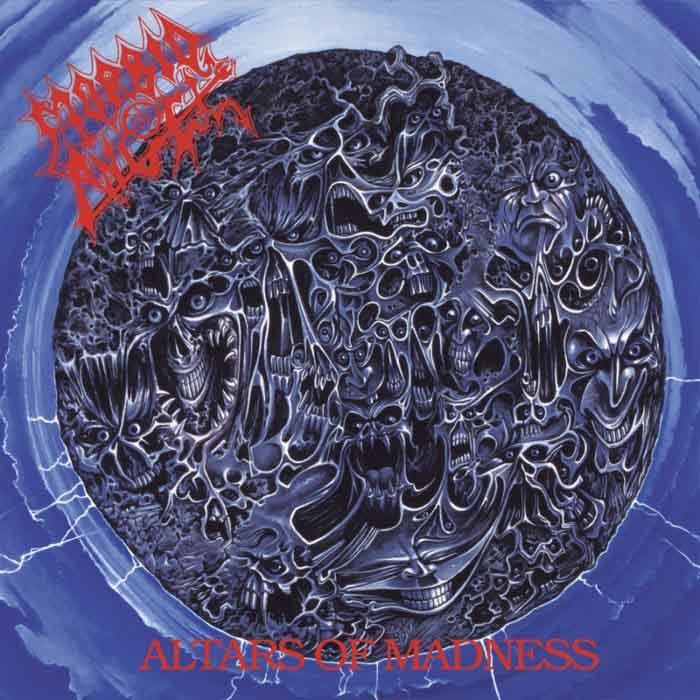Morbid Angel recorded what was supposed to be their debut album in 1986. Compositionally excellent and novel, Abominations of Desolation was a Manhattan project of death metal as a truly musically distinct sub-genre. However, band leader Trey Azagthoth and then producer Dave Vincent were unhappy with the recording. Azagthoth quickly fired drummer/vocalist Browning and bassist John Ortega, and shelved the album, which Ortega later released as a bootleg. Vincent and Azagthoth had a point though: Browning’s drumming was shaky and he sounded like a wimp. His drumming lacked power, never making use of blast beats while his vocals could have come out of a whiny fourteen-year-old.
Altars of Madness fixed that and sped up the tempo to become the metal atom bomb Azagthoth wanted. Pete Sandoval of Terrorizer was a drummer capable of the polyrhythms, blasting lock-step with the riffs, and Lombardian double-kick rolls the band desired while Vincent provided a more consistent vocal delivery. The Morrisound production was heavy, all-analog, and crystal clear. None of the production trickery the studio would become infamous for was used; The triggers, quantization, sample-replacement, and Marshall Valvestate solid-state amps would come later as record labels sent bands of incompetent musicians there wanting to record material far beyond their instrumental proficiency to actually play.1
Unfortunately, the original CD version of Altars of Madness lacked low-end weight resulting in typewriter kicks while the LP had all the usual flaws of vinyl such as compression of treble transients, monaural bass, pops, and surface noise. The later CD remasters were all overly compressed and awful. Fortunately for fans, Earache has pressed the album to wax from the tapes as part of their Full Dynamic Range series and put the 24-bit digitization of the mix tape up for sale on Bandcamp. No compression was used in the mastering of the digital version to make the guitars and vocals twice as loud as everything else and reduce instrumental space for losers with iPhones. The lossless, digital FLACs retain the grunt of the original 1989 LP with the increased clarity that modern analog to digital converters bring, making the long out of print original CD sound a bit grainy in comparison. The Full Dynamic Range versions are both much better than the tossable coasters with the bonus live DVD that came out about a decade ago.
The digital version may be purchased from the Bandcamp link above and the LP from Earache’s webstore.
1The interviews with the Morris brothers in Jason Netherton’s Extremity Retained go into great technical detail about how Morrisound and Scott Burns accomplished all of this prior to digital audio workstations becoming common.
Tags: Altars of Madness, death metal, earache records, full dynamic range, loudness war, morbid angel, reissue, trey azagthoth



Altars of Madness used bass drum triggers, fam.
There’s a Morbid Angel documentary on Youtube (I only partly watched), https://www.youtube.com/watch?v=w6zBKwFxHW0, and towards the beginning of that, Tom Morris talks about recording the drum parts of Altars Of Madness and Blessed Are The Sick and he specifically claims otherwise.
That’s Blessed only where they pasted a sample on top of the original track.
I meant to express “Tom Morris said it ain’t so”, ie, no studio ‘ehancements’ on the first and no triggers on the second (just the two samples). Is my style really that contorted??
Morris said that and then when into detail on how they “enhanced” Pete’s kit on Blessed!
Not really the drum kit, ie using a bass drum trigger, but the recorded drum tracks, by overlaying “maybe a snare and a kick sample” onto the track based on signals taken from the erase head of a tape recorder in order to provide a few milliseconds of ‘advance warning’ before the additional sample had to hit the tape.
The the original claim (‘use of bass drum triggers’) is completely wrong for the first record (due to budget constraints) and technically wrong for the second: Morris said he believed the bass and snare drum sound on that was altered after recording it drum triggers weren’t being used (being a professional computer nerd aka programmer, these attempts at qualifying wrongness seem just wrong …)
I would also highly recommend the Carnage and From Enslavement to Obliteration reissues from this series. I didn’t even realize that the CD version of the former had such problems until I heard this version. From the moment that the first chord after the synthetic intro didn’t clip the way I had become subconsciously accustomed to, I was hooked. The Napalm Death one is even more essential because now you can hear exactly what is going on in every riff, even the super fast ones, and because of that, you get even more perspective on why modern grindcore sucks compared to the ancient stuff.
Are you referring to the MOSH232 CD? Because I was planning on purchasing that soon. I’m curious because I listened to this version of Altars of Madness earlier and my untrained ear couldn’t detect a perceptible difference.
Hold off on that CD; I’ll post something on the Carnage remasters later today. For Altars of Madness, it’s mostly the drums on the original LP and the “Full Dynamic Range” version being clearer than the old CDs.
So where’s the shit in the fucking Carnage remasters? Any fucking day now, since it’s past later
I realized that Earache has their FDR version on YouTube. Comparing that with the NECRO 3 version which I’m assuming is the original and the MOSH 232 version, it seems like they’ve reduced the distortion on the rhythm guitar so that the drums are more distinct and the leads stand out more prominently during solos. If I had to say, it’s as if the clarity of the album has steadily increased with each subsequent release, but it’s hard to say because the FDR version seems quieter overall.
There is no less distortion, you are hearing the mix tape without any additional compression or eq in mastering. YouTube is a terrible way to judge audio quality too.